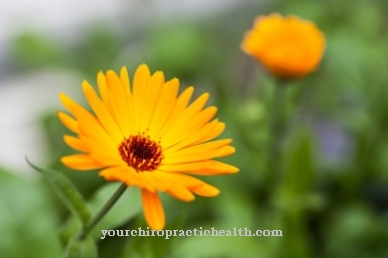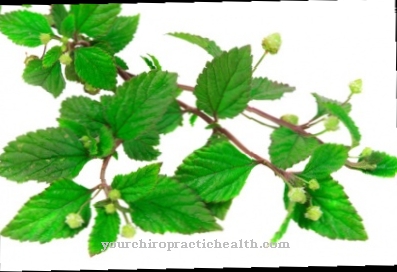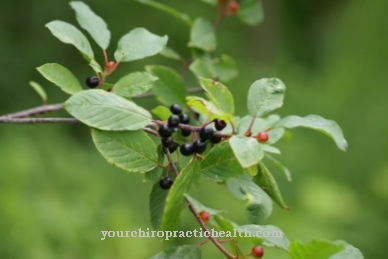The Gold balm (Monarda didyma) is a plant from the mint family. It grows primarily in the USA and is used as an ornamental, useful and medicinal plant.
Occurrence & cultivation of the golden balm

Here you can find them in many gardens today. The golden balm is a perennial perennial plant. It grows herbaceous and can reach a height of between 80 and 150 centimeters. The square stems are upright. Opposite short-stalked leaves sit on them. The leaves are 15cm long and 5cm wide. The leaf margin is slightly sawn. Between June and September the red lip flowers appear at the upper end of the plant stem.
Effect & application
The main active ingredients in gold balm are essential oils. Thymol, Carvacrol, Cymen, Geraniol, Linalool and Camphene give the plant its scent and effect. Tannins, bitter substances and anthocyanins are also components of golden balm. The essential oils of the golden balm are similar to the essential oils of the thyme. The spectrum of activity and the areas of application of the two plants are therefore comparable.
Gold balm has a positive effect on the respiratory tract. It loosens stuck mucus in the bronchi and frees the airways. So it is often used for coughs and colds. For a gold balm tea, 1/4 liter of boiling water is poured over a teaspoon of dried or fresh herb. The tea is ready after a steeping time of five minutes. For a gentler tea extract, the golden balm tea can also be prepared cold.
For this, the herb is put in 250ml cold water in the morning. This cold approach is then heated in the evening. For respiratory diseases such as cough or bronchitis, two to three cups of tea per day are recommended. The tea is very tasty. Its lemony-spicy aroma is reminiscent of bergamot. Since the golden balm also has a sweat-inducing effect, the tea is also suitable for feverish infections. Gold balm tea is also drunk for nausea and indigestion.
The golden balm strengthens the digestive organs and can relieve gas. The plant also has an influence on the nervous system. It helps with headaches, migraines and difficulty falling asleep. The flower heads are particularly suitable for a relaxing tea. To regulate menstrual disorders or for menopausal symptoms, the balm can be taken as a tea or tincture.
It contains an active ingredient similar to phytoestrogens. Phytoestrogens are secondary plant substances that have a structural similarity to estrogens and can thus achieve an estrogenic or anti-estrogenic effect. For a balm tincture, a handful of 250ml flower heads with 40 percent alcohol are placed in a sealable vessel. The mixture should soak in the sun for three to four weeks and shake once a day.
Then the batch is filtered off and filled into a dark bottle. Depending on your taste, the tincture can be diluted to 20-30 percent with boiled water. It is recommended to take 15-20 drops daily. Other uses of tea and tincture are weather sensitivity, headaches and sleep disorders. Extracts from golden balm can also be used to support mild depression.
Both the tea and the diluted tincture can be used for external use on wounds and for skin care. The oil extract of the golden balm also has a refreshing, cleansing and revitalizing effect in skin care. The oil extract is made similar to the tincture. The alcohol is simply replaced with olive or sunflower oil. But be careful, too high a concentration of gold balm irritates the skin.
However, the golden balm is not just a medicinal plant. Due to its spicy taste, it can also be used in the kitchen. Like thyme, it gives salads, vegetable and meat dishes a Mediterranean flavor.
Importance for health, treatment & prevention
The golden balm has a long tradition as a medicinal plant. Already in 1569 it was mentioned by the Spanish botanist Monardes in a book about the American world of flowers. The golden balm owes its name to this botanist. Even the Oswego Indians drank gold balm tea. They used the herb mainly for colds and stomach pains. That is why the tea made from golden balm is often referred to as Oswego tea.
The golden balm has been cultivated since 1737. The plant gained historical importance at the end of the 18th century. At that time, the colonists in the USA boycotted the actually very popular black tea that was supplied from England. Alternatively, tea was drunk from the golden balm. This resistance to British colonial policy went down in history as the Boston Tea Party.
In Europe, the golden balm is still more of an ornamental than a medicinal plant. It may therefore not be mentioned in the monographs of Commission E. Commission E is a commission of experts consisting of biologists, doctors, naturopaths, pharmacologists and toxicologists. It is part of the Federal Institute for Drugs and Medical Devices (BfArM) and collects scientific material on the effects of medicinal plants.
Since the ingredients of the golden balm are very similar to those of the thyme, one could orientate oneself on the monograph of the commission E and the monograph of the European Scientific Cooperative on Phytotherapy (ESCOP) for the thyme. Both societies certify that thyme has a positive effect on respiratory diseases.

























.jpg)


